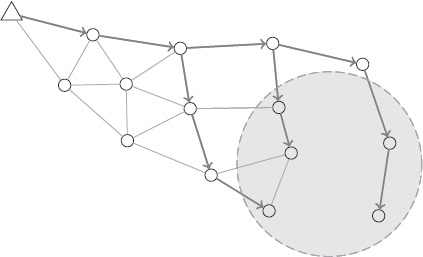5.2 GEOCASTING WITH GUARANTEED DELIVERY
In a geocasting task, one source node sends a message to all the nodes located in a given geographic region, as illustrated in Figure 5.4. In the context of sensor and actuator networks, this operation is usually applied from an actuator node to all the sensor located in a region of particular sensing interest, this region having possibly different shapes (circular, oval, rectangular, etc.). This message could carry for example, a request for immediate data from any sensor in the region, or inform the sensors about a new location to regularly report to, or give any other instruction that relates to the given region. Geocasting could be used, for example, to monitor the pollution at given locations around a factory (e.g., near the river), or successively requesting the sensors along a moving object trajectory (e.g., tracking the progression of an animal in a forest). Note that geocasting in these cases represents only the request leg, and does not concern the way the data are reported in the reverse direction.

Figure 5.4 Example of geocasting.
As for the other routing principles (e.g., broadcasting, multicasting, or anycasting), a geocasting task can be greatly improved by preliminary putting in sleep mode all the sensor nodes that are not useful to the task, that is, not used to connect the target region, nor to cover it. Such preliminary ...
Get Wireless Sensor and Actuator Networks: Algorithms and Protocols for Scalable Coordination and Data Communication now with the O’Reilly learning platform.
O’Reilly members experience books, live events, courses curated by job role, and more from O’Reilly and nearly 200 top publishers.

